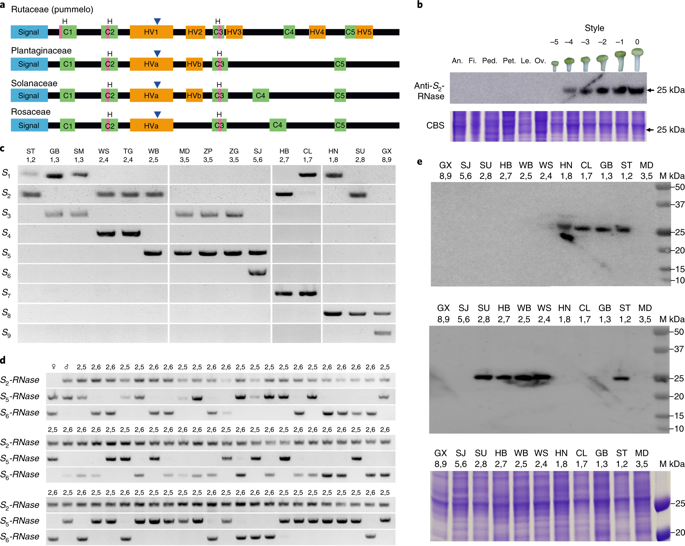Nature Plants ( IF 15.8 ) Pub Date : 2020-02-13 , DOI: 10.1038/s41477-020-0597-3 Mei Liang 1, 2 , Zonghong Cao 1 , Andan Zhu 3 , Yuanlong Liu 4 , Mengqin Tao 1 , Huayan Yang 1 , Qiang Xu 1 , Shaohua Wang 5 , Junjie Liu 1 , Yongping Li 1 , Chuanwu Chen 6 , Zongzhou Xie 1 , Chongling Deng 6 , Junli Ye 1 , Wenwu Guo 1 , Qiang Xu 1 , Rui Xia 4 , Robert M Larkin 1 , Xiuxin Deng 1 , Maurice Bosch 7 , Vernonica E Franklin-Tong 8 , Lijun Chai 1

|
Self-incompatibility (SI) is an important mechanism that prevents self-fertilization and inbreeding in flowering plants. The most widespread SI system utilizes S ribonucleases (S-RNases) and S-locus F-boxes (SLFs) as S determinants. In citrus, SI is ancestral, and Citrus maxima (pummelo) is self-incompatible, while Citrus reticulata (mandarin) and its hybrids are self-compatible (SC). Here, we identify nine highly polymorphic pistil-specific, developmentally expressed S-RNases from pummelo that segregate with S haplotypes in a gametophytic manner and cluster with authentic S-RNases. We provide evidence that these S-RNases function as the female S determinants in citrus. Moreover, we show that each S-RNase is linked to approximately nine SLFs. In an analysis of 117 citrus SLF and SFL-like (SLFL) genes, we reveal that they cluster into 12 types and that the S-RNases and intra-haplotypic SLF and SLFL genes co-evolved. Our data support the notion that citrus have a S locus comprising a S-RNase and several SLFs that fit the non-self-recognition model. We identify a predominant single nucleotide mutation, Sm-RNase, in SC citrus, which provides a ‘natural’ loss of function. We show that SI–SC transitions due to the Sm-RNase initially arose in mandarin, spreading to its hybrids and became fixed. Identification of an evolutionarily distant new genus utilizing the S-RNase-based SI system, >100 million years separated from the nearest S-RNase family, is a milestone for evolutionary comparative studies.
中文翻译:

柑橘突变体 Sm-RNase 的自相容性进化
自交不亲和性(SI)是阻止开花植物自我受精和近亲繁殖的重要机制。最普遍的 SI 系统利用S核糖核酸酶 ( S - RNases) 和S-基因座 F-box (SLF) 作为S决定簇。在柑橘中,SI 是祖先的,Citrus maxima (pummelo) 是自交不亲和的,而Citrus reticulata (普通话) 及其杂种是自交亲和 (SC)。在这里,我们从柚子中鉴定出九种高度多态的雌蕊特异性、发育表达的S- RNase,它们以配子体的方式与S单倍型分离,并与真正的S-聚集在一起。核糖核酸酶。我们提供证据表明这些S -RNase在柑橘中作为雌性S决定簇发挥作用。此外,我们表明每个S -RNase 都与大约九个 SLF 相关联。在对 117 个柑橘类SLF和 SFL 样 ( SLFL ) 基因的分析中,我们发现它们聚集成 12 种类型,并且S-RNase和单倍型内SLF和SLFL基因共同进化。我们的数据支持这样的观点,即柑橘有一个S基因座,包含一个S-RNase和几个适合非自我识别模型的SLF 。我们确定了一个主要的单核苷酸突变,Sm -核糖核酸酶,在 SC 柑橘中,提供“自然”功能丧失。我们表明,由于S m -RNase 引起的 SI-SC 转变最初出现在普通话中,扩散到其杂种并变得固定。利用基于S -RNase 的 SI 系统鉴定一个进化上遥远的新属,与最近的S -RNase 家族相距超过 1 亿年,是进化比较研究的里程碑。











































 京公网安备 11010802027423号
京公网安备 11010802027423号